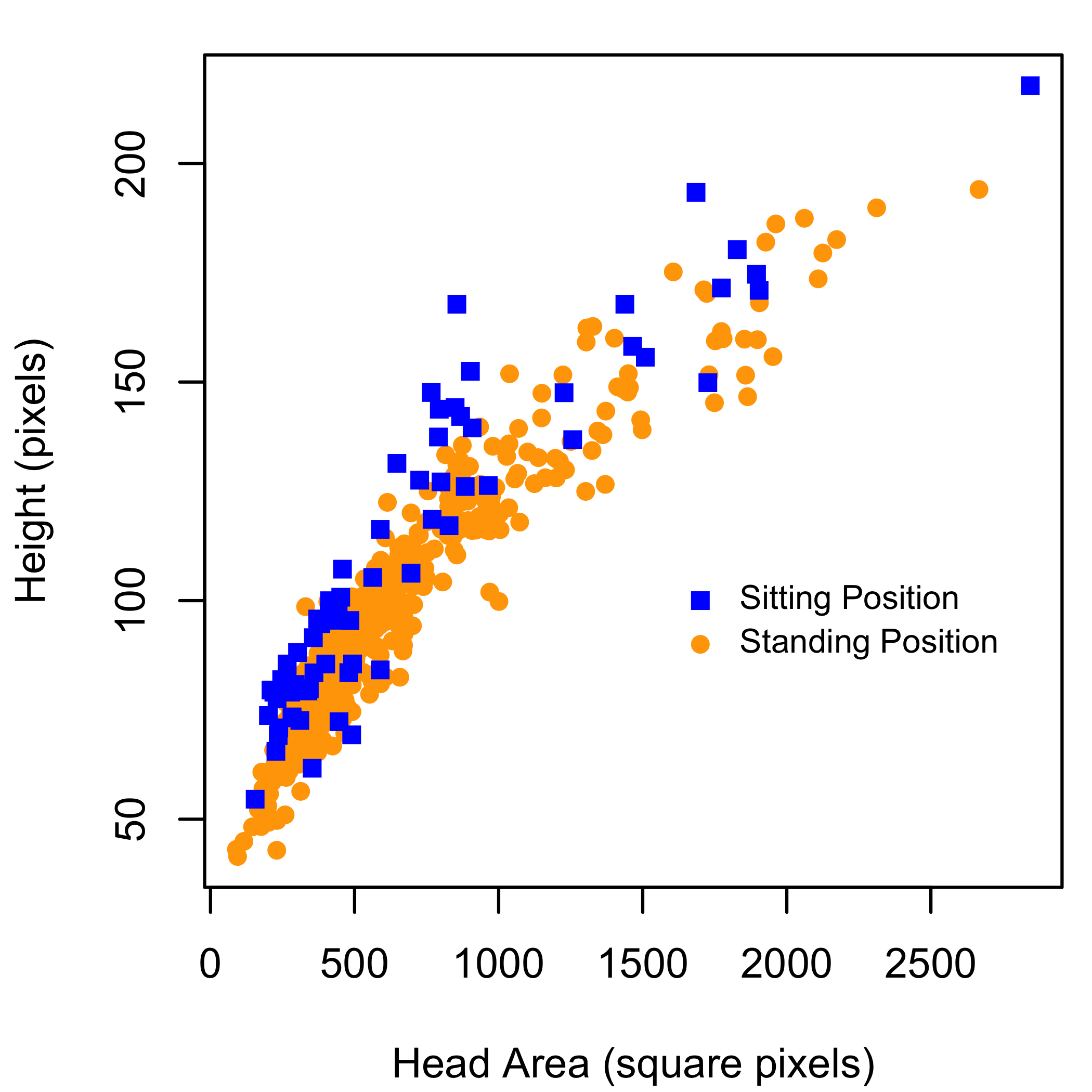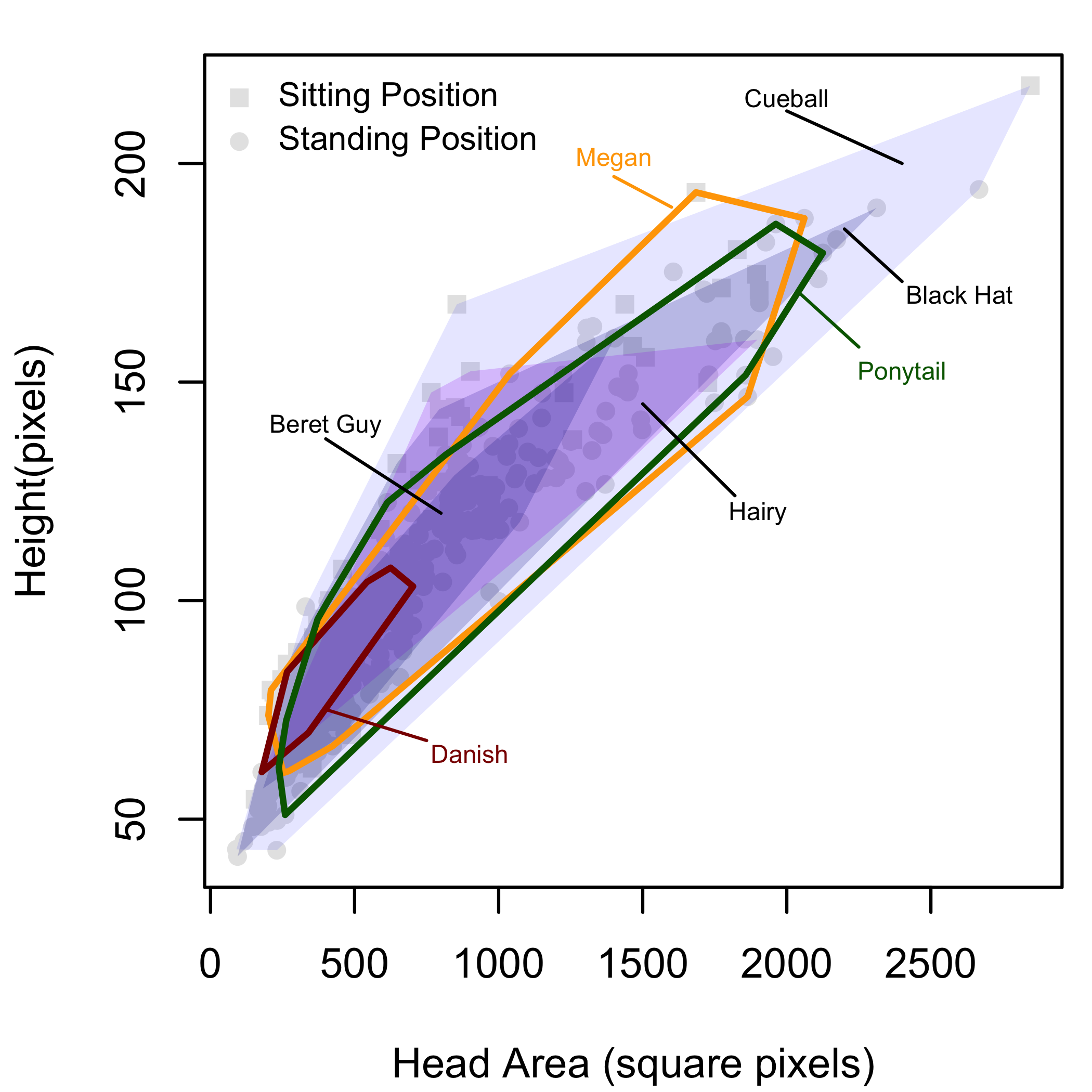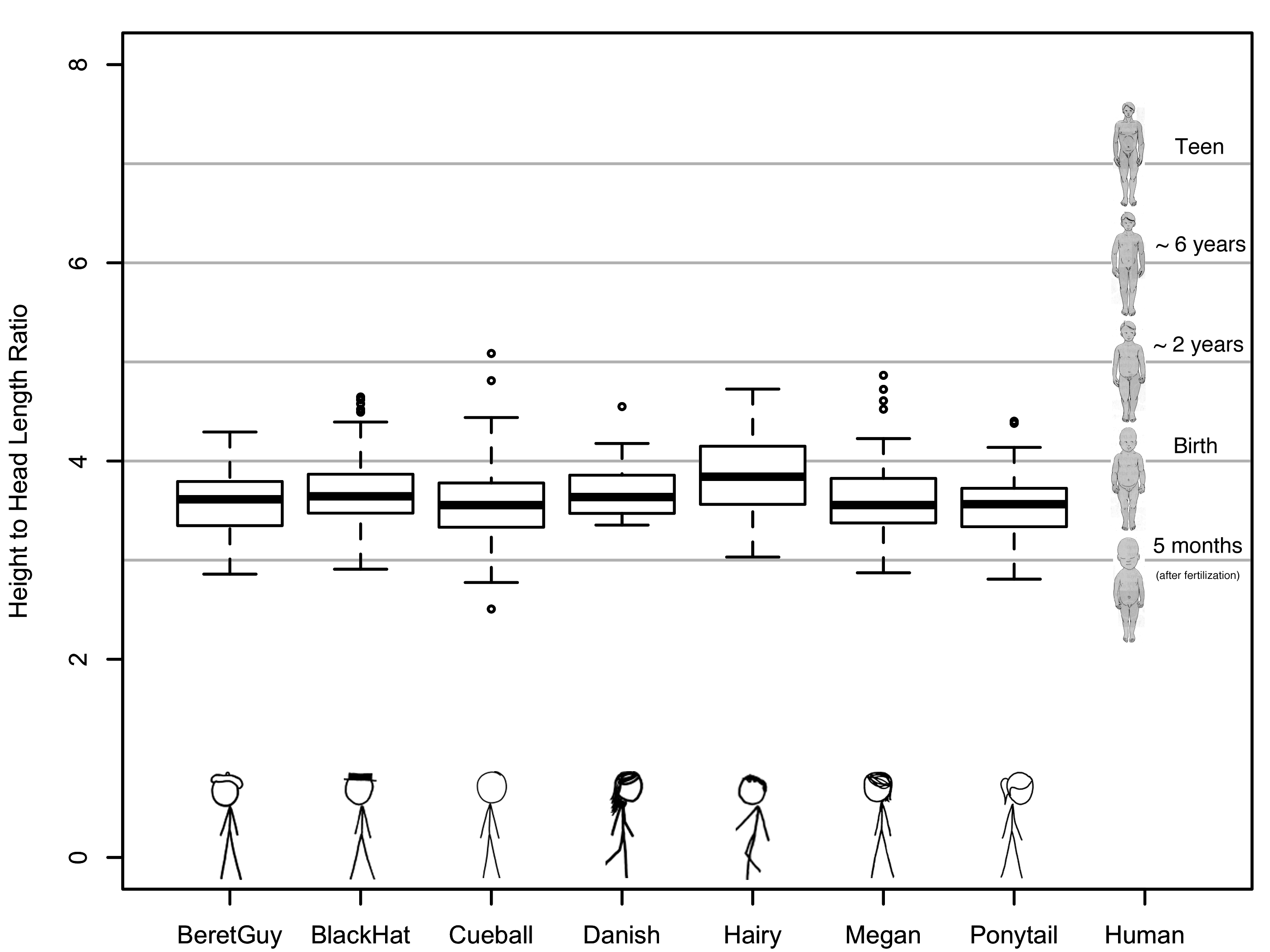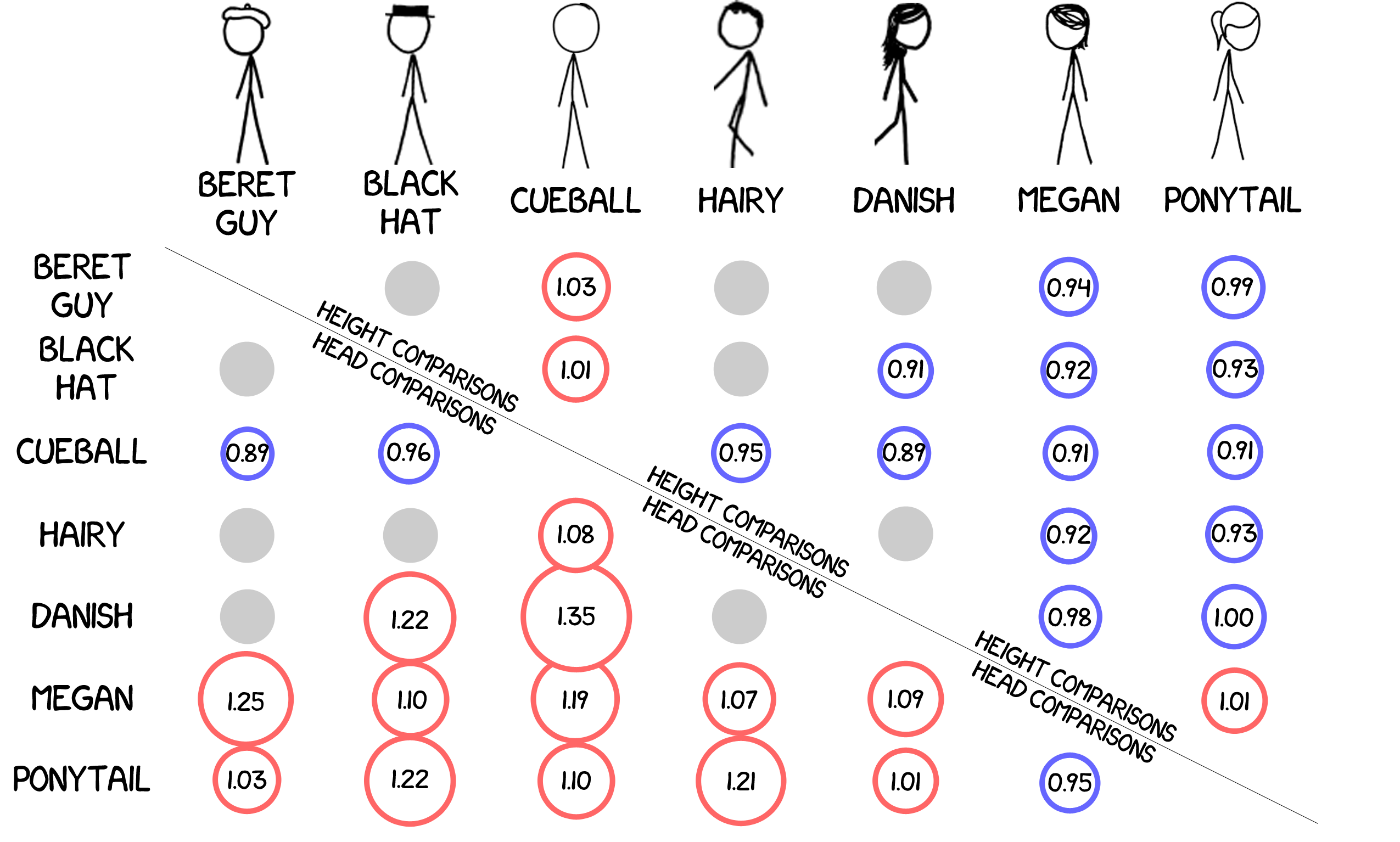
Tweet
December 11, 2014
Proceedings of the Natural Institute of Science | Volume 1 | HARD 8
Comparative morphology of popular xkcd characters
Matt J. Michel1
1 - Editor, PNIS

What if somebody measured the morphological traits of the characters in the popular webcomic xkcd and conducted a comparative analysis?
Anonymous, Somerville, MA
The answer would look something like Figure 2. However, there are other interesting conclusions one can make from this type of analysis: for instance, that the characters in xkcd are babies, like, literally babies. We’ll get to that in a second.
xkcd is a fantastic webcomic founded by ex-NASA roboticist Randall Munroe in September 2005. To date, Munroe has published over 1400 xkcd comics (at a rate of about 3 per week), and the website itself receives about 3 million page views a day. It has also inspired several other websites including explainxkcd.com and xkcdsucks.blogspot.com (which gets, according to some estimates, about 700 visitors per day).
One defining characteristic of xkcd is that almost every character is drawn as a stick figure. In fact, the characters are only distinguishable by hairstyle (bald, ponytail, dark-hair, etc.) and headgear (black hat, beret, white hat, etc.), to such a degree that names of these characters are often derived by their respective cranial traits. Explainxkcd.com lists 5 main male characters and 3 main female characters:
Beret Guy – male; wears a beret
Black Hat – male; wears a black boater-style hat
Cueball – male; bald and typically hatless
Hairy – male; short, dark hair; also typically hatless
White Hat – male; wears a white boater-style hat
Danish – female; dark hair extending past shoulders
Megan – female; dark hair stopping at the shoulders
Ponytail – female; light-colored hair in a ponytail
As stick figures that can be easily and consistently measured and differentiated, these characters make great specimens for a simple comparative morphological analysis: traits of a character can be measured and then compared to the traits of other characters to uncover various similarities and differences.
We randomly sampled 400 of the 1400+ comics and downloaded all those that: 1) contained at least one of the above characters and 2) showed a fully visible body (e.g., not obstructed by piece of furniture). That left us with 117 comics. Then we measured 2 morphological traits: 1) total body height (including head) and 2) area of head. We also noted if the character was in a seated or standing position.
It is at this point where we would love to tell you that we wrote some kind of awesome python code that automatically obtained these measurements for us. It is also at this point where we tell you that, collectively, we have the programming skills of an 8-month old inbred capybara. Thus, we were stuck with measuring each trait manually. All measurements were done in the program ImageJ. Click here for a .csv file containing all the measurements.
Altogether, we ended up with 476 measurements of height (in pixel units) and head area (in square pixels units). The breakdown of number of measurements by character was: Cueball (173 measurements), Megan (88), Black Hat (75), Ponytail (58), Danish (29), Beret Guy (28), Hairy (23) and White Hat (2). Because of the low sample size for White Hat, we removed him from all further analyses.
Head Area vs. Height measurements for all 474 points are given in Figure 1 (below). There are two important observations to be made here. The first is that figures in a seated position are drawn with taller bodies than figures in a standing position, regardless of character identity. This difference seems somewhat intuitive, as it is probably difficult to maintain identical proportions of characters in different poses (especially if the artist is not interested in following standard human proportions)[1]. The second is that this relationship is nonlinear (e.g., height seems to asymptote as head size increases). Nonlinearity is actually a common feature in studies that examine how any attribute of a group of individuals varies with body size (the scientific term for this type of study is “allometry”). So, it seems as though Munroe is somewhat acquainted with the literature on allometric scaling[2].

To distinguish all the characters from each other in Figure 1, we can draw something called minimum convex polygons (Figure 2, below). These are made by connecting all the outer dots for a particular character to make a convex polygon (i.e., a polygon with no indents). Looking at Figure 2, there doesn’t seem to be a huge difference in any of the characters; they all seem to have roughly the same head-height relationship. But there is maybe a small tendency for the male characters to have larger heads (yet, some of this is due to the differences in standing vs. sitting).

We can go a little bit further with this data by calculating height/head length ratios for each character (after first transforming head area into head diameter). The results are plotted in Figure 3 (below). We could do some statistical analyses on this data (*cough*Hairy-is-significantly-different-than-Cueball*cough*[3]), but, overall, it looks like most characters have a height to head length ratio of about 3.5 to 4.

This is where it gets a bit interesting because height:head length ratios have been obtained for humans ever since Da Vinci’s Vitruvian Man. The standard for adults is that about 7.5 to 8 head lengths should fit within a person’s height (Schuenke et al. 2010). But, here we see that Munroe draws his characters as having about 3.5 to 4 heads per height. For humans, that particular ratio best describes newborns (i.e., less than 12 months; Barcsay 2001, Hoddinott 2007, Stark 2007, Schuenke et al. 2010). So, either Munroe’s characters are amazingly precocious babies, or they are just adults with radically enlarged heads[4]. Let’s hope for the latter, because some of the implications of the former become disturbing (and illegal) when you consider certain comics [links not provided you sicko].
Fig. 2 shows that, overall, the characters seem similar in their dimensions. But a quick glance at comics that show characters side-by-side (or at least in the same panel) reveals that Munroe does like to draw heights and head sizes differently (see here). To analyze these differences, we enlisted our team of inbred capybara coders to find all the instances from our sample in which at least two characters were drawn in the same comic panel and both were in a standing position. We then compared the average height and head area for all the available comparisons.
These results are given in Figure 4 (below), which may require a bit more explanation. The circles and numbers above the diagonal line refer to comparisons of height between each character; circles and numbers below the diagonal line refer to comparisons of head sizes. The color of the circle indicates if the measurement of the character in the column header is greater than (red circles) or less than (blue circles) the measurement of the character in the row header (e.g., so Black Hat is taller than Danish but shorter than Cueball). The size of the circle corresponds to the size of this difference, and the number is the ratio of the two character’s heights or head sizes (e.g., Cueball is 1.03 times taller than Beret Guy). Gray circles represent no data.

What information can we get from this figure? First, Cueball is always drawn the biggest when he’s around other characters. He’s taller and has a bigger head than everyone else. Megan is the opposite: she’s the shortest and has the smallest head. Second, males are always drawn taller than females. The exact proportional differences actually match well with real-life data: in the United States females are about 0.92 times as tall as males on average, and in the xkcd universe, the females are mostly between 0.89 and 0.92 times as tall as males (the exception being Beret Guy, who, by this analysis, may be considered as the most feminine of the male characters).
The last interesting piece of information from Figure 4 concerns the height preferences of humans when choosing mates. A study on the height preferences of Polish college students found that the most preferred height difference among female-male couples is 0.926 (i.e., females being 0.92 times taller than males; Pawlowski 2002).
How does this ratio hold for the xkcd characters? The most common romantic couple in xkcd is Megan-Cueball (height difference ratio of 0.906). However, it seems that Megan should actually prefer Hairy (ratio of 0.917[5]), and there’s no denying their romantic attraction. In fact, Megan does seem to have left Cueball for another person at some point in the comic, and our analysis suggests that that person was Hairy. Yet, for his part, Hairy matches up perfectly with Ponytail (ratio of 0.926), so maybe Hairy left Megan for Ponytail (although their date got off to a bad start). Ponytail matches about equally well with Hairy and Black Hat (ratio of 0.927), but there never was an indication of a Black Hat-Ponytail coupling.
So, where does that leave Danish? Of all the other xkcd characters, her height matches the best with Black Hat’s (ratio of 0.910). Loyal readers recognize the Danish-Black Hat couple as probably one of the strongest (it would have to be to survive this). While their height difference doesn’t exactly match Pawlowski’s set standard, that’s probably fine since their relationship probably doesn’t match anybody else’s (except perhaps Bonnie and Clyde’s).
So, to review, we’ve found out that xkcd characters get taller when they sit down, are probably newborns, and match well with American gender differences in height. We also used comparative morphology to uncover some possible love triangles, which appears to be first such use of comparative morphology. Okay, maybe the second-such use.
Footnotes
[1] We checked Google Scholar to see if differences in height of seated vs. standing figures are a common occurrence among drawers, but couldn’t find any relevant papers. However, we did find this paper that says that children between 3 and 6 years-old draw dogs in more detail than they draw men. [Return to main text]
[2] Although Munroe has this relationship backwards: head sizes stop growing around age 5, while height continues to grow until the mid-20’s. Thus, head size should asymptote as height increases. [Return to main text]
[3] *cough*Tukey’s HSD, P = 0.004*cough* Excuse me. [Return to main text]
[4] Or Munroe is heavily influenced by the painter John Currin (example artwork here). [Return to main text]
[5] The Megan:Black Hat ratio is 0.915. [Return to main text]

Proceedings of the Natural Institute of Science (PNIS) by https://instsci.org/ is licensed under a Creative Commons Attribution-ShareAlike 4.0 International License.